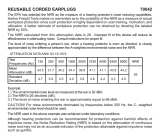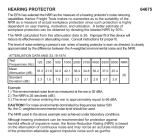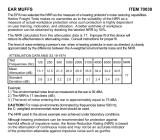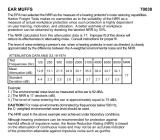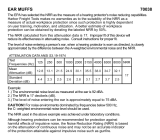
In Table 1, the NRRs for the four HPDs
that have been discussed, are presented.
These NRRs were calculated using the
manufacturers’ laboratory data as well as
the NAL data. Note that for two devices
the NRR based on the NAL data is <1.
This simply says that if we wish to exam-
ine the least possible protection we are
likely to find (i.e. only 2% of the popula-
tion will receive less protection than this)
that the overall protection provided by
these two devices is virtually zero.
It may be that with RW or estimated RW
data, a 2
s
correction is too severe and
that we should examine a 1
s
correction
(84% protection, i.e. 16% will get less
than this number). These values are also
shown in Table 1. (In fact, the single num-
ber rating listed in the NAL report is the
SLC
80
, which is very similar in concept
15,17
to the NRR, except that it uses a 1
s
cor-
rection and lacks a spectral safety fac-
tor.) Even these more “optimistic” values
demonstrate that certain insert protectors
may be suitable for noise exposures only
slightly greater than 90 dBA, a supposi-
tion substantiated by the Royster study
cited above.
Conclusions
There appears to be a less than ad-
equate correlation between manufactur-
ers’ (laboratory) attenuation data and the
RW performance of HPDs. Suitably de-
signed laboratory tests, such as the work
performed by the NAL, can provide rea-
sonable estimates of RW performance.
Comparison between NAL data and in-
field data from three authors substanti-
ates this fact. This is an important point,
because it suggests that existing HPD
test methodologies, such as ANSI S3.19-
1974
11
, can be effectively utilized with
only simple modifications regarding sub-
ject selection, training, fitting and HPD
preparation procedures.
The NAL and in-field data suggest, for
example, that the E-A-R foam earplug
should be more effective in use than other
insert hearing protectors. This was con-
firmed independently by an in-field TTS
study which found that E-A-R Plugs per-
formed significantly better than V-51R
and 3-flange inserts in a 95 dBA noise
environment.
Finally, if a single number rating is to be
used with RW type data, such as the
NAL data, perhaps a 1
s
instead of a 2
s
correction is more appropriate. This
suggestion is reasonable, since an
attempted 98% protection criterion may
be feasible if unrealistically high
laboratory data are utilized, but is
certainly extreme if RW estimated data
are developed and used for NRR
calculations.
References and Footnotes
1. Berger, E.H. - The EARLog series is available upon
request from Aearo Company.
2. National Acoustic Laboratories (1979). Attenuation of
Hearing Protectors (2nd Edition) Commonwealth
Department of Health, Australia.
3. American National Standards Institute (1957). Method
for the Measurement of Real-Ear Attenuation of Ear
Protectors at Threshold Standard Z24. 22-1957
(R1971), New York, NY.
4. Waugh, E. (1974). Pure-Tone, Third-Octave, and
Octave Band Attenuation of Ear Protectors J. Acoust.
Soc. Am, Vol. 56, No. 6, 1866-1869.
5. Edwards, R.G., Hauser, W.P., Moiseev, N.A.,
Broderson, A.B., and Green, W.W. (1978) Effectiveness
of Earplugs as Worn in the Workplace. Sound and
Vibration, Vol. 12, No. 1, 12-22.
6. National Institute for Occupational Safety and Health
(1978) A Field Investigation of Noise Reduction
Afforded by Insert-Type Hearing Protectors, U.S. Dept.
of HEW, Report No 79-115, Cincinnati, OH.
7. Regan, D. E. (1977). Real Ear Attenuation of Personal
Ear Protective Devices Worn in Industry. Audiology and
Hearing Education, Vol. 3, No. 1, 16-17
8. Regan, D.E. (1975). Real Ear Attenuation of Personal
Ear Protective Devices Worn in Industry. Doctoral
Thesis at Kent State University.
9. Padilla, M. (1976). Ear Plug Performance in Industrial
Field Conditions Sound and Vibration, Vol. l0, No. 5, 33-
36.
10. MSHA Denver Technical Support Center - Field
evaluation of earmuffs, to be published 1980.
11. Acoustical Society of America (1975). Method for the
Measurement of Real-Ear Protection of Hearing
Protectors and Physical Attenuation ol Earmuffs
Standard ASA STD1-1975 (ANSI S3.19- 1974). New
York, NY.
12. Royster, L.H. (1979). Effectiveness of Three Different
Types of Ear Protectors in Preventing TTS J. Acoust
Soc. Am., Vol. 66, Supp. 1, paper DD 16.
13. Royster, L.H. (1980). An Evaluation of the Effective-
ness of Two Different Insert Types of Ear Protection in
Preventing TTS in an Industrial Environment. Am. Ind.
Hyg. Assoc. J., Vol. 41, No. 3, 161-169.
14. Royster, L.H., Lilley, D.T., and Thomas, W.G. (1980)
Recommended Criteria for Evaluating the Effective-
ness of Hearing Conservation Programs. Am. Ind. Hyg.
Assoc. J., Vol. 41, No. 1, 40-48.
15. Berger, E.H. (1979). EARLog #2 - Single Number
Measures of Hearing Protector Noise Reduction.
Available upon request from Aearo Company.
16. EPA (1979). Noise Labeling Requirements for Hearing
Protectors Federal Register, Vol. 42, No. 190, 40 CFR
Part 211, 56139-56147.
17. Waugh, R. (1976). Calculated In-Ear A-Weighted
Sound Levels Resulting from Two Methods of Hearing
Protector Selection. Annals of Occupational
Hygiene,Vol. 19, 193-202.
TABLE 1
NRR VALUES BASED ON MANUFACTURERS’ LABORATORY
DATA AND NAL DAT
A
HEARING PROTECTOR
V-51R
Swedish Wool
Earmuff
Foam Insert
NRR*
MFG
18
16
25
29
NRR**
NAL
NRR***
NAL, 1s
0
1
6
14
9
6
13
19
* NRR based on manufacturers’ laboratory data with 2s correction.
** NRR based on NAL data with 2
s
correction.
*** NRR based on NAL data with 1
s
correction.
NOTE: For more current information on
real-world performance and
NRR-related issues see
EARLog #20,
The Naked Truth
About NRRs.
E•A•RLog® is a registered trademark of Aearo Company. Copyright 1996. First printing 1980.
LIT. CODE 30295 2/99 AG





